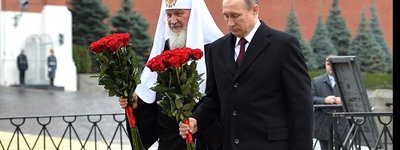Witnesses to Persecution
One might ask why a nation of some 144,000,000 would risk its international reputation to persecute a religious sect numbering no more than 175,000 followers.
On 15 March 2017, the Russian Ministry of Justice lodged an application with the Supreme Court requesting an order to dissolve the Jehovah’s Witnesses Administrative Center and 395 regional branches. On 20 April, the Supreme Court of the Russian Federation banned the Jehovah’s Witnesses as an organization. The branches’ activities, consisting chiefly of holding meetings and distributing literature, were suspended pending a Court ruling. Some 175,000 members of the church are affected. The basis for the order was alleged violation of a Russian anti-extremism law which punishes, among other things, statements that one’s religion is superior to others. Another motive for the ban may have been the Witnesses’ traditional refusal of blood transfusions. (Halya Coynash, “Russia Reinstates Darkest Soviet Days by Banning the Jehovah’s Witnesses,” Human Rights in Ukraine, 21 April 2017)
Indeed, a Russian federal law on Combating Extremist Activity punishes “propaganda of exclusiveness, superiority or inferiority of an individual based on his/her religious identity” or “attitude to religion.” While this law is applicable only to organizations, which it can dissolve, Criminal Code sec. 282 applies penalties to individuals, and has been used against Jehovah’s Witnesses as well as Muslims who meet for study and prayer.
The Jehovah’s Witnesses were founded by Charles Taze Russell in Pittsburgh, Pennsylvania (USA) in the 1870s. Incorporated as a society in 1884, the group was particularly concerned with spreading its interpretation of the Bible, focusing on the second coming of Christ. Typically, the Witnesses would proselytize (and still do) by going from house to house. However, Russell also travelled abroad, visiting Europe, Russia, and Japan. The Witnesses also published a magazine (known since 1939 as The Watch Tower) and other materials. By World War I, they had followers in the Russian empire. (Zoe Knox, “Preaching the Kingdom Message: The Jehovah’s Witnesses and Soviet Secularization,” in Catherine Wanner, ed., State Secularism and Lived Religion in Soviet Russia and Ukraine, New York: 2012, pp. 244-71).
Jehovah’s Witnesses gained converts in western Ukrainian as well as Belarusian territories that had been incorporated into Poland after World War I. They also spread to the Baltic states and Romania. They were severely persecuted by the Nazis. After eastern Poland, the Baltic states, and northern Bukovyna (Romania) were occupied by the USSR in World War II, there were mass deportations of Witnesses to Siberia – in 1941 and in 1951. The Witnesses, however, saw these deportations as opportunities to continue proselytizing. In accord with their teachings, groups of Witnesses either refused to register with the authorities in accord with Soviet law, or were not allowed to do so. Their corporate body, the Watch Tower Bible and Tract Society, was officially banned in the USSR in 1961. (Knox, op. cit.)
In Ukraine, they were mostly rural and 95% ethnically Ukrainian. Typically, Witnesses would meet secretly in private homes. They resisted the draft, objected to atheist schooling, and refused blood transfusions. They were especially numerous in Transcarpathia and the Crimea. (Vasyl Markus, “Religion and Nationalism in Ukraine,” in Pedro Ramet, ed., Religion and Nationalism in Soviet and East European Politics, Durham, NC: 1984, p. 89). The Witnesses believed that all governments were controlled by Satan, and therefore did not recognize either the USSR or the American government. They saw the Cold War as the clash of the kingdom of the North and the kingdom of the South described in the Book of Daniel (chapter 11), which would lead to Armageddon. In the USSR as well as in the United States, they refused military service and avoided participation in government-sponsored activities. In both countries, this sometimes brought them into conflict with the law. In the U.S., this resulted in a number of important Supreme Court decisions. In the USSR, it resulted in persecution. Apparently, the Soviet authorities never fully understood the teachings of the Jehovah’s Witnesses: despite their pacifism, they were accused of war-mongering (because of their expectation of Armageddon); despite their conflicts with the US government, they were branded as agents of American imperialism. (Knox, op. cit.).
The Watch Tower Bible and Tract Society was allowed to register with the Soviet authorities on 28 February 1991 and in the Russian SFSR on 27 March of that year. The following year, after the fall of the USSR, the Witnesses held an international convention in St. Petersburg. (Ibid.)
But in view of the Putin regime’s harsh treatment of the Witnesses as well as of non-violent Muslims, in its most recent report the US Commission on International Religious Freedom includes Russia among the “countries of particular concern.” Russia shares this distinction with such notable human rights violators as Iran, North Korea, Nigeria, and Sudan.
It is thus strange that some U.S. conservatives are looking to Russia as a beacon of religion. This is evidently because the Russian government opposes such anti-Christian trends as same-sex marriage. Of course, these enthusiasts ignore the fact that while the Russian government is friendly to the Orthodox Church, it is hardly a haven for Evangelical churches (to which many such enthusiasts belong), or for other religious groups such as Catholics -- including Russian Catholics.
One might ask why a nation of some 144,000,000 would risk its international reputation to persecute a religious sect numbering no more than 175,000 followers. Perhaps in that regard, Russia has nothing to lose. But what does it have to gain?










